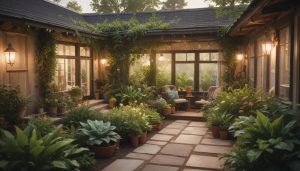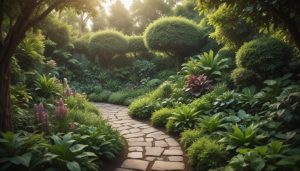Secrets Behind a Beautiful Low Maintenance Yard
Daniel Fisher August 25, 2025
Ever wondered how to enjoy a lush, inviting yard that doesn’t demand endless hours of upkeep? Discover practical strategies for crafting a low maintenance landscape, from drought-resistant plants to smart lawn alternatives—tailored for anyone dreaming of beautiful home gardens that practically take care of themselves.
Why Choose a Low Maintenance Yard
For many, the idea of a low maintenance yard sparks visions of effortless afternoons. Traditional lawns and flower beds can be a source of pride, but also an ongoing chore. Time spent mowing, watering, weeding, and fertilizing quickly adds up. Homeowners increasingly look for alternatives that reduce effort without compromising curb appeal. Rethinking your outdoor space can mean less time spent on yard tasks and more leisure hours enjoying the outdoors.
Switching to a low maintenance yard can also deliver tangible savings. With the cost of water, fertilizers, and lawn equipment rising, running a traditional lawn can increase utility bills and household expenses. Shrinking the footprint of thirsty grass or replacing it with native, drought-tolerant species keeps costs and environmental impact lower. These sustainable choices are kinder to both wallet and planet, offering long-term value. Integrating these ideas is gaining popularity among busy families and retirees alike.
The benefits reach beyond free time and reduced bills. Sustainable landscaping often attracts wildlife—birds, pollinators, and beneficial insects thrive in diverse environments. This approach can improve soil health, foster biodiversity, and minimize chemical exposure to children and pets. Families interested in eco-friendly living or reducing their carbon footprint often turn to native landscaping practices, transforming their yard into a haven that flourishes with minimal input.
Smart Plant Choices for Lasting Impact
Plant selection plays a leading role in effortless landscape design. Drought-resistant plants stand up to both heat and neglect, requiring less care and water. Popular options include lavender, ornamental grasses, sedum, yarrow, and coneflower. These varieties offer vibrant color and interesting textures. Their deep root systems not only withstand dry spells but also anchor soil, reducing erosion. By mixing perennials with native plants, gardeners create visual interest that evolves through the seasons without constant replanting.
Going local is a winning strategy: native plants naturally thrive in the region’s soil and climate. These species typically resist pests and diseases better than imports, reducing the need for chemical intervention. Many gardeners consult local cooperative extensions or reputable plant lists to guide their choices. Beyond flowers, evergreens and hardy shrubs serve as silent heroes. They provide year-round structure and privacy, require minimal pruning, and often stay green or vibrant even in cooler months.
Groundcover plants—like creeping thyme, mondo grass, and ajuga—offer lush, weed-smothering alternatives to lawn. Once established, they require trimming only once or twice per year. Flowering groundcovers can crowd out unwanted weeds, keep soil cool, and add pops of color to otherwise unused corners. These options are growing in popularity among sustainable garden enthusiasts, especially when combined with hardscaping elements such as paths and patios for even lower upkeep.
Lawn Alternatives That Save Time and Water
The allure of a perfect green lawn is strong, but it comes with real maintenance demands. Alternatives like artificial turf, clover, or xeriscaping mean less mowing, watering, and fertilizing. Artificial turf gives the appearance of grass without the upkeep—great for play areas or pet runs. For those preferring living greenery, clover lawns are experiencing a resurgence. Clover fixes nitrogen in the soil, stays green in dry conditions, and feels soft underfoot. These options support sustainable living and reduce household water use.
Xeriscaping—the practice of landscaping with plants adapted to arid conditions—minimizes or eliminates the need for irrigation. Succulents, cacti, and ornamental grasses can form striking patterns and require little attention. Rock gardens, gravel, and mulch support this aesthetic and keep pathways tidy. Homeowners in drought-prone areas especially value these approaches. Rain gardens, designed to absorb stormwater, can further decrease runoff while nourishing deep-rooted plants.
Transitioning to a lawn alternative can be done gradually. Start by converting a small section, outlining new planting beds, or integrating mulch and groundcover islands. Over time, expanding these features reduces the attentiveness traditional turf requires. The flexibility of these updates allows every homeowner to customize their yard based on preferences, climate, and lifestyle—all while reducing the regular upkeep once thought unavoidable.
Mulch, Soil Health, and Weed Control Made Easy
Mulch does more than enhance curb appeal. Applying a thick layer of organic mulch conserves soil moisture, fights off weeds, and regulates soil temperature. Hardwood, pine bark, or straw mulch are popular options that gradually improve soil as they break down. Mulching also prevents compacted soil—roots can penetrate easily, and flowers and shrubs show more vigor. For homeowners looking to simplify, mulch stands out for its many benefits in low maintenance yards.
Healthy soil is the underpinning of a thriving landscape. Simple practices—like topdressing beds with compost and minimizing heavy tilling—boost fertility and biodiversity underground. Native plants, by their nature, rarely need supplemental feeding. For vegetable or pollinator beds, consider rotating crops or using cover crops during off-seasons to replenish nutrients naturally. These habits reduce reliance on fertilizers, leading to fewer weeds and lower maintenance requirements overall.
Weed control is central to a no-fuss garden. Landscape fabric or newspaper beneath mulch provides additional weed blockade without harmful chemicals. Planting groundcovers densely further crowds out invaders. Pulling young weeds by hand after rain ensures deeply rooted interlopers are easier to manage. Mulch, healthy soil, and smart spacing together ensure weeds remain a minor concern—not an ongoing battle that steals enjoyment from home garden spaces.
Design Strategies for Great Looks and Little Work
Thoughtful landscape design amplifies beauty while shrinking chores. Start with structure: paths, patios, and gravel areas break up large expanses of lawn and make outdoor living enjoyable. Raised beds or containers offer flexible planting and easier access. Choosing curves over straight lines softens the look of a yard and makes mowing and trimming less time-consuming. For families seeking easier outdoor maintenance, these design tactics bring both form and function to the forefront.
Grouping plants by water and sunlight needs means less worry about inconsistent growth or overwatering. Placing frequently used herbs or edibles near the kitchen saves steps and encourages harvest. Trees planted in the right spot offer natural shade, cooling the home and reducing air conditioning demands. These strategies reflect a growing movement toward ecological landscaping—yards that work harder for their owners while demanding less.
Low maintenance doesn’t have to mean low style. Ornamental boulders, benches, birdbaths, and garden art add personality and draw the eye away from less-manicured areas. Seasonal bulbs ensure color bursts even before perennials emerge. Incorporating lighting extends outdoor living into the evenings, adding ambiance without extra yard work. Layering these design elements elevates the look of a yard while keeping care requirements to a minimum.
Practical Irrigation for Stress-Free Upkeep
Efficient watering is essential for any easy-care landscape. Drip irrigation systems deliver water right to roots, wasting less and lowering the chance of disease from wet foliage. Soaker hoses are simple to install in beds or under mulch. Automated timers take guesswork out of watering, ensuring plants get what they need even during vacations or busy periods. These systems offer true peace of mind for homeowners who value simplicity and reliability in their yards.
Mulch and smart plant selection work hand-in-hand with efficient irrigation. Deep-rooted natives, succulents, or tough perennials thrive with less-frequent deep watering rather than daily shallow doses. Rain barrels and cisterns collect stormwater, reducing tap water use and lowering utility bills. Many local programs offer rebates or support for home irrigation upgrades, highlighting water savings as a community-wide priority.
Troubleshooting common irrigation issues becomes much simpler with regular system checks. Inspect for leaks, clogs, or incorrect sprinkler coverage and adjust as needed. Seasonal adjustments, like turning off systems in the rainy season, further conserve resources. By integrating practical, water-wise irrigation into landscape plans, ongoing maintenance shrinks while plant health and yard enjoyment increase.
References
1. U.S. Environmental Protection Agency. (n.d.). Water-Smart Landscapes. Retrieved from https://www.epa.gov/watersense/water-smart-landscapes
2. National Wildlife Federation. (n.d.). Create a Wildlife Habitat Garden. Retrieved from https://www.nwf.org/garden-for-wildlife
3. University of California Agriculture and Natural Resources. (n.d.). Lawn Alternatives. Retrieved from https://ucanr.edu/sites/scmg/Lawn_Replacement/Lawn_Alternatives/
4. U.S. Department of Agriculture Forest Service. (n.d.). Native Plants. Retrieved from https://www.fs.fed.us/wildflowers/Native_Plant_Materials/Native_Gardening/index.shtml
5. Missouri Botanical Garden. (n.d.). Mulch. Retrieved from http://www.missouribotanicalgarden.org/gardens-gardening/your-garden/help-for-the-home-gardener/advice-tips-resources/gardening-by-topic/mulch.aspx
6. Colorado State University Extension. (n.d.). Xeriscaping: Creative Landscaping. Retrieved from https://extension.colostate.edu/topic-areas/yard-garden/xeriscaping-creative-landscaping-7-228/







